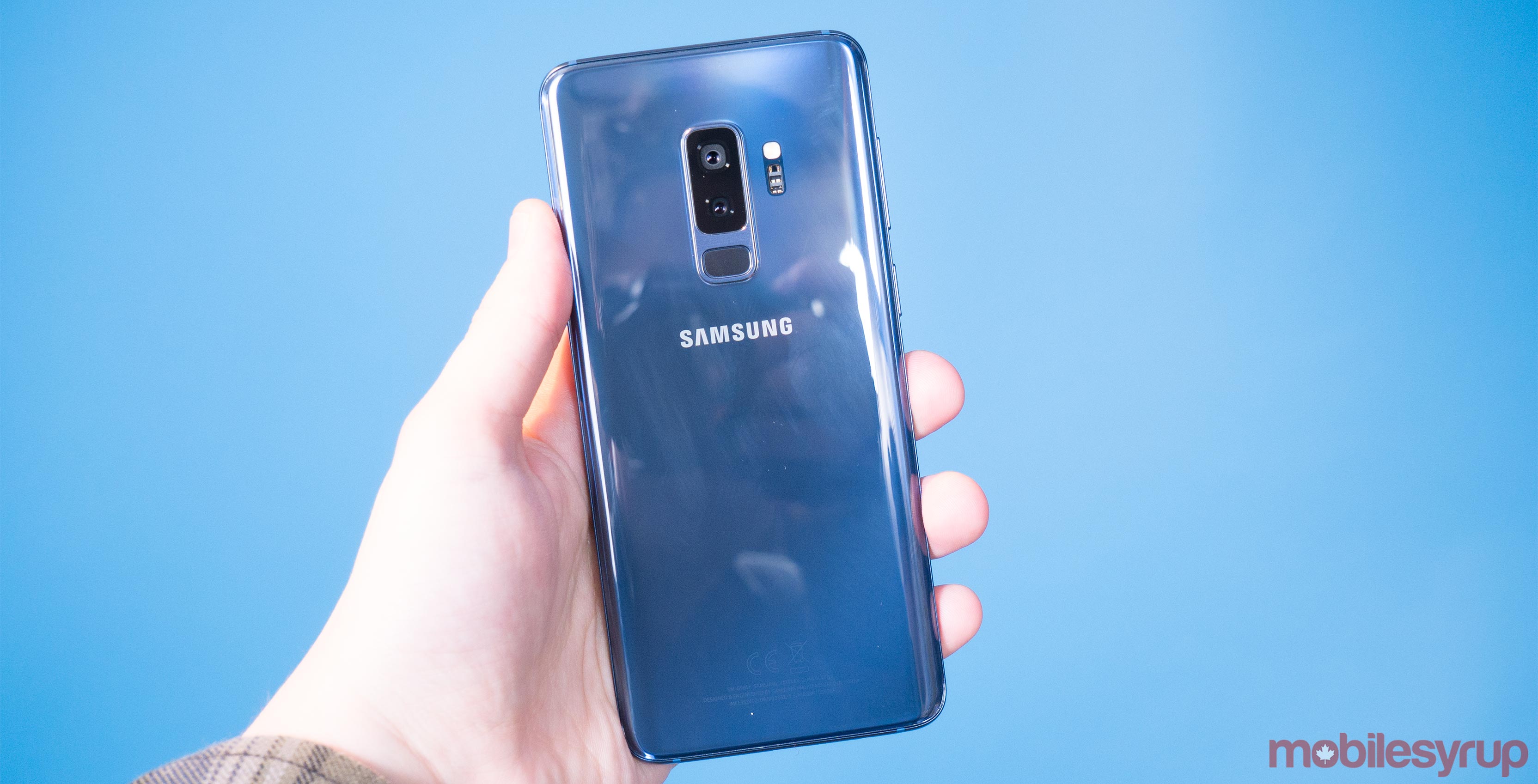
Samsung has finally revealed the Galaxy S9 and Galaxy S9+.
The phones appear similar to the company’s previous S8 and S8+ models, with a couple of key differences.
Samsung Galaxy S8
Samsung Galaxy S8+
Samsung Galaxy S9
Samsung Galaxy S9+
Display
5.8-inch Super AMOLED display, 18.5:9 aspect ratio
6.2-inch Super AMOLED display, 18.5:9 aspect ratio
5.8-inch, Super AMOLED display, 18.5:9 aspect ratio
6.2-inch Super AMOLED display, 1440 x 2960 pixels, 18.5:9 aspect ratio
Processor
Snapdragon 835 (Exynos 8895 in Europe and other regions)
Snapdragon 835 (Exynos 8895 in Europe and other regions)
Snapdragon 845 (Exynos 9810 in Europe and other regions)
Snapdragon 845 (Exynos 9810 in Europe and other regions)
RAM
4GB of RAM
4GB of RAM
4GB of RAM
6GB of RAM
Storage
64GB (expandable up to 256GB)
64GB (expandable up to 256GB)
64GB (expandable up to 400GB)
64GB (expandable up to 400GB)
Dimensions (in.)
148.9 x 68.1 x 8.0mm
159.5 x 73.4 x 8.1mm
147.7 x 68.7 x 8.5mm
158.1 x 73.8 x 8.5mm
Weight
152g
173g
163g
189g
Rear Facing Camera
12-megapixel (f/1.7, OIS)
12-megapixel (f/1.7, OIS)
12-megapixel (variable: f/1.5 - f/2.4, OIS), dual-LED flash
12-megapixel (variable f/1.5 - f/2.4, OIS) + 12-megapixel (f.2.4, OIS) dual-LED flash
Front Facing Camera
8-megapixel (f/1.7)
8-megapixel (f/1.7)
8-megapixel (f/1.7)
8-megapixel (f/1.7)
OS
Android 8.0 Oreo
Android 7.0 Oreo
Android 8.0 Oreo
Android 8.0 Oreo
Battery
3,000 mAh
3,500 mAh
3,000mAh
3,500mAh
Network Connectivity
GSM/HSPA/LTE
GSM/HSPA/LTE
GSM/HSPA/LTE
GSM/HSPA/LTE
Sensors
Accelerometer, Barometer, Fingerprint Sensor, Gyro Sensor, Geomagnetic Sensor, Hall Sensor, Heart Rate Sensor, Proximity Sensor, RGB Light Sensor, Iris Sensor, Pressure Sensor
Accelerometer, Barometer, Fingerprint Sensor, Gyro Sensor, Geomagnetic Sensor, Hall Sensor, Heart Rate Sensor, Proximity Sensor, RGB Light Sensor, Iris Sensor, Pressure Sensor
Iris scanner, fingerprint (rear-mounted), Intelligent Scan, accelerometer, gyro, proximity, compass, barometer, heart rate, SpO2
Iris scanner, fingerprint (rear-mounted), Intelligent Scan, accelerometer, gyro, proximity, compass, barometer, heart rate, SpO2
SIM Type
Nano SIM
Nano SIM
Nano SIM
Nano SIM
Launch Date
March 29, 2017
March 29, 2017
March 16, 2018
March 16, 2018
Misc
Colours: Midnight Black, Orchid Gray, Arctic Silver, Coral Blue and Maple Gold| Bixby, IP68 certified water-resistant, 3.5mm headphone jack, USB Type-C.
Colours: Black, Orchid Gray, Silver, Gold and Blue| Bixby, IP68 water and dust resistance, 3.5mm headphone jack, USB Type-C.
Colour: Titanium Gray, Lilac Purple (in Canada) | IP68 water/dust resistant, 18:9 aspect ratio, wireless charging, USB type C
Colours: Titanium Gray, Lilac Purple (in Canada) | IP68 water/dust resistant, wireless charging, USB, type C, Bluetooth 5.0
Display
Samsung Galaxy S8
5.8-inch Super AMOLED display, 18.5:9 aspect ratio
Samsung Galaxy S8+
6.2-inch Super AMOLED display, 18.5:9 aspect ratio
Samsung Galaxy S9
5.8-inch, Super AMOLED display, 18.5:9 aspect ratio
Samsung Galaxy S9+
6.2-inch Super AMOLED display, 1440 x 2960 pixels, 18.5:9 aspect ratio
Processor
Samsung Galaxy S8
Snapdragon 835 (Exynos 8895 in Europe and other regions)
Samsung Galaxy S8+
Snapdragon 835 (Exynos 8895 in Europe and other regions)
Samsung Galaxy S9
Snapdragon 845 (Exynos 9810 in Europe and other regions)
Samsung Galaxy S9+
Snapdragon 845 (Exynos 9810 in Europe and other regions)
RAM
Samsung Galaxy S8
4GB of RAM
Samsung Galaxy S8+
4GB of RAM
Samsung Galaxy S9
4GB of RAM
Samsung Galaxy S9+
6GB of RAM
Storage
Samsung Galaxy S8
64GB (expandable up to 256GB)
Samsung Galaxy S8+
64GB (expandable up to 256GB)
Samsung Galaxy S9
64GB (expandable up to 400GB)
Samsung Galaxy S9+
64GB (expandable up to 400GB)
Dimensions (in.)
Samsung Galaxy S8
148.9 x 68.1 x 8.0mm
Samsung Galaxy S8+
159.5 x 73.4 x 8.1mm
Samsung Galaxy S9
147.7 x 68.7 x 8.5mm
Samsung Galaxy S9+
158.1 x 73.8 x 8.5mm
Weight
Samsung Galaxy S8
152g
Samsung Galaxy S8+
173g
Samsung Galaxy S9
163g
Samsung Galaxy S9+
189g
Rear Facing Camera
Samsung Galaxy S8
12-megapixel (f/1.7, OIS)
Samsung Galaxy S8+
12-megapixel (f/1.7, OIS)
Samsung Galaxy S9
12-megapixel (variable: f/1.5 - f/2.4, OIS), dual-LED flash
Samsung Galaxy S9+
12-megapixel (variable f/1.5 - f/2.4, OIS) + 12-megapixel (f.2.4, OIS) dual-LED flash
Front Facing Camera
Samsung Galaxy S8
8-megapixel (f/1.7)
Samsung Galaxy S8+
8-megapixel (f/1.7)
Samsung Galaxy S9
8-megapixel (f/1.7)
Samsung Galaxy S9+
8-megapixel (f/1.7)
OS
Samsung Galaxy S8
Android 8.0 Oreo
Samsung Galaxy S8+
Android 7.0 Oreo
Samsung Galaxy S9
Android 8.0 Oreo
Samsung Galaxy S9+
Android 8.0 Oreo
Battery
Samsung Galaxy S8
3,000 mAh
Samsung Galaxy S8+
3,500 mAh
Samsung Galaxy S9
3,000mAh
Samsung Galaxy S9+
3,500mAh
Network Connectivity
Samsung Galaxy S8
GSM/HSPA/LTE
Samsung Galaxy S8+
GSM/HSPA/LTE
Samsung Galaxy S9
GSM/HSPA/LTE
Samsung Galaxy S9+
GSM/HSPA/LTE
Sensors
Samsung Galaxy S8
Accelerometer, Barometer, Fingerprint Sensor, Gyro Sensor, Geomagnetic Sensor, Hall Sensor, Heart Rate Sensor, Proximity Sensor, RGB Light Sensor, Iris Sensor, Pressure Sensor
Samsung Galaxy S8+
Accelerometer, Barometer, Fingerprint Sensor, Gyro Sensor, Geomagnetic Sensor, Hall Sensor, Heart Rate Sensor, Proximity Sensor, RGB Light Sensor, Iris Sensor, Pressure Sensor
Samsung Galaxy S9
Iris scanner, fingerprint (rear-mounted), Intelligent Scan, accelerometer, gyro, proximity, compass, barometer, heart rate, SpO2
Samsung Galaxy S9+
Iris scanner, fingerprint (rear-mounted), Intelligent Scan, accelerometer, gyro, proximity, compass, barometer, heart rate, SpO2
SIM Type
Samsung Galaxy S8
Nano SIM
Samsung Galaxy S8+
Nano SIM
Samsung Galaxy S9
Nano SIM
Samsung Galaxy S9+
Nano SIM
Launch Date
Samsung Galaxy S8
March 29, 2017
Samsung Galaxy S8+
March 29, 2017
Samsung Galaxy S9
March 16, 2018
Samsung Galaxy S9+
March 16, 2018
Misc
Samsung Galaxy S8
Colours: Midnight Black, Orchid Gray, Arctic Silver, Coral Blue and Maple Gold| Bixby, IP68 certified water-resistant, 3.5mm headphone jack, USB Type-C.
Samsung Galaxy S8+
Colours: Black, Orchid Gray, Silver, Gold and Blue| Bixby, IP68 water and dust resistance, 3.5mm headphone jack, USB Type-C.
Samsung Galaxy S9
Colour: Titanium Gray, Lilac Purple (in Canada) | IP68 water/dust resistant, 18:9 aspect ratio, wireless charging, USB type C
Samsung Galaxy S9+
Colours: Titanium Gray, Lilac Purple (in Canada) | IP68 water/dust resistant, wireless charging, USB, type C, Bluetooth 5.0
On the outside
Both the S9 and the S8 feature 5.8-inch displays, while the S9+ and the S8+ share a 6.2-inch screen size. However, the newer handsets are smaller than Samsung’s previous models. That’s due to the S9 and S9+ featuring smaller bezels and a greater screen-to-body ratio.
All four handsets make use of the company’s Super AMOLED display technology and feature an 18.5:9 aspect ratio.
Another major difference is the placement of the S8 and S8+’s fingerprint scanner. With the S8 and S8+, Samsung placed the fingerprint scanner to the right of the rear camera. Now the S9 and S9+’s fingerprint sensors are located below their cameras, making them more reachable.
Camera
Camera-wise, both phones are very different than their predecessors. The S9 uses a 12-megapixel camera sensor, similar to the S8 in terms of pixels, but has a variable aperture lens. A camera with a variable aperture lens has the ability to switch between multiple aperture settings. The S9 specifically can change from a f/1.5 aperture to a narrower f/2.4 aperture. However, unlike a DSLR lens, the phone lacks aperture sizes between f/1.5 and f/2.4. The S8’s 12-megapixel camera is limited to a f/1.7 aperture.
Meanwhile, the S9+ uses a dual rear camera setup with two 12-megapixel sensors, one of the lenses is also a variable aperture with the ability to switch to either a f/1.5 aperture or a f/2.4 aperture, while the other is fixed at a f/2.4 aperture.
The S9 and S9+ are also capable of recording video at a super fast 960fps.
Specs and features
The Galaxy S9 and S9+ both use Qualcomm’s Snapdragon 845 chipset in Canada, which is a step above the Galaxy S8 and S8+’s processor from last year. The S9+, however, uses 6GB of RAM while the S8+ only has 4GB.
The Samsung Galaxy S9 and S9+ both have a new Animoji-like feature that Samsung calls AR emoji. Unlike Apple’s Animoji, the phone maps the user’s face through a process that takes approximately 20 seconds. The handsets then transform the 2D image into a cartoony 3D replica that looks similar to the user.
The S9 and S9+ also uses a feature called “Intelligent Scan,” which combines the handset’s iris scanning capabilities and face recognition, replacing either unlock
Samsung’s new handsets also use Dolby Sound giving the phone stereo sound output.
For more on the Galaxy S9 and S9+ check out MobileSyrup’s hands-on here.


